Quan Wang
Arden
Improving Few-Shot Change Detection Visual Question Answering via Decision-Ambiguity-guided Reinforcement Fine-Tuning
Dec 31, 2025Abstract:Change detection visual question answering (CDVQA) requires answering text queries by reasoning about semantic changes in bi-temporal remote sensing images. A straightforward approach is to boost CDVQA performance with generic vision-language models via supervised fine-tuning (SFT). Despite recent progress, we observe that a significant portion of failures do not stem from clearly incorrect predictions, but from decision ambiguity, where the model assigns similar confidence to the correct answer and strong distractors. To formalize this challenge, we define Decision-Ambiguous Samples (DAS) as instances with a small probability margin between the ground-truth answer and the most competitive alternative. We argue that explicitly optimizing DAS is crucial for improving the discriminability and robustness of CDVQA models. To this end, we propose DARFT, a Decision-Ambiguity-guided Reinforcement Fine-Tuning framework that first mines DAS using an SFT-trained reference policy and then applies group-relative policy optimization on the mined subset. By leveraging multi-sample decoding and intra-group relative advantages, DARFT suppresses strong distractors and sharpens decision boundaries without additional supervision. Extensive experiments demonstrate consistent gains over SFT baselines, particularly under few-shot settings.
The Prism Hypothesis: Harmonizing Semantic and Pixel Representations via Unified Autoencoding
Dec 22, 2025Abstract:Deep representations across modalities are inherently intertwined. In this paper, we systematically analyze the spectral characteristics of various semantic and pixel encoders. Interestingly, our study uncovers a highly inspiring and rarely explored correspondence between an encoder's feature spectrum and its functional role: semantic encoders primarily capture low-frequency components that encode abstract meaning, whereas pixel encoders additionally retain high-frequency information that conveys fine-grained detail. This heuristic finding offers a unifying perspective that ties encoder behavior to its underlying spectral structure. We define it as the Prism Hypothesis, where each data modality can be viewed as a projection of the natural world onto a shared feature spectrum, just like the prism. Building on this insight, we propose Unified Autoencoding (UAE), a model that harmonizes semantic structure and pixel details via an innovative frequency-band modulator, enabling their seamless coexistence. Extensive experiments on ImageNet and MS-COCO benchmarks validate that our UAE effectively unifies semantic abstraction and pixel-level fidelity into a single latent space with state-of-the-art performance.
Anatomical Region-Guided Contrastive Decoding: A Plug-and-Play Strategy for Mitigating Hallucinations in Medical VLMs
Dec 19, 2025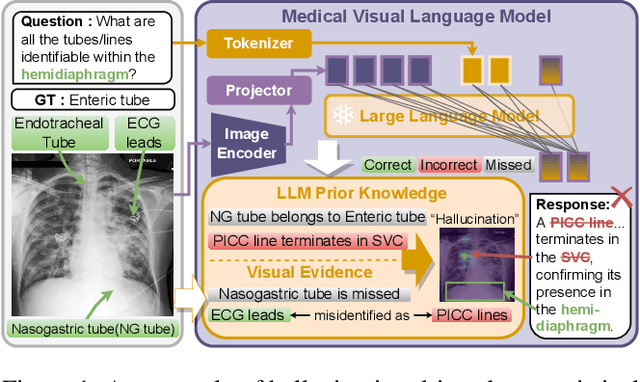
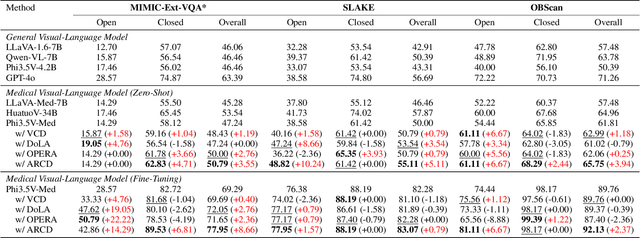


Abstract:Medical Vision-Language Models (MedVLMs) show immense promise in clinical applicability. However, their reliability is hindered by hallucinations, where models often fail to derive answers from visual evidence, instead relying on learned textual priors. Existing mitigation strategies for MedVLMs have distinct limitations: training-based methods rely on costly expert annotations, limiting scalability, while training-free interventions like contrastive decoding, though data-efficient, apply a global, untargeted correction whose effects in complex real-world clinical settings can be unreliable. To address these challenges, we introduce Anatomical Region-Guided Contrastive Decoding (ARCD), a plug-and-play strategy that mitigates hallucinations by providing targeted, region-specific guidance. Our module leverages an anatomical mask to direct a three-tiered contrastive decoding process. By dynamically re-weighting at the token, attention, and logits levels, it verifiably steers the model's focus onto specified regions, reinforcing anatomical understanding and suppressing factually incorrect outputs. Extensive experiments across diverse datasets, including chest X-ray, CT, brain MRI, and ocular ultrasound, demonstrate our method's effectiveness in improving regional understanding, reducing hallucinations, and enhancing overall diagnostic accuracy.
CheXPO-v2: Preference Optimization for Chest X-ray VLMs with Knowledge Graph Consistency
Dec 19, 2025Abstract:Medical Vision-Language Models (VLMs) are prone to hallucinations, compromising clinical reliability. While reinforcement learning methods like Group Relative Policy Optimization (GRPO) offer a low-cost alignment solution, their reliance on sparse, outcome-based rewards inadvertently encourages models to "overthink" -- generating verbose, convoluted, and unverifiable Chain-of-Thought reasoning to justify answers. This focus on outcomes obscures factual errors and poses significant safety risks. To address this, we propose CheXPO-v2, a novel alignment framework that shifts from outcome to process supervision. Our core innovation is a Knowledge Graph Consistency Reward mechanism driven by Entity-Relation Matching. By explicitly parsing reasoning steps into structured "Disease, Relation, Anatomy" triplets, we provide fine-grained supervision that penalizes incoherent logic and hallucinations at the atomic level. Integrating this with a hard-example mining strategy, our approach significantly outperforms GRPO and state-of-the-art models on benchmarks like MIMIC-CXR-VQA. Crucially, CheXPO-v2 achieves new state-of-the-art accuracy using only 5k samples, demonstrating exceptional data efficiency while producing clinically sound and verifiable reasoning. The project source code is publicly available at: https://github.com/ecoxial2007/CheX-Phi4MM.
Scaling Spatial Intelligence with Multimodal Foundation Models
Nov 17, 2025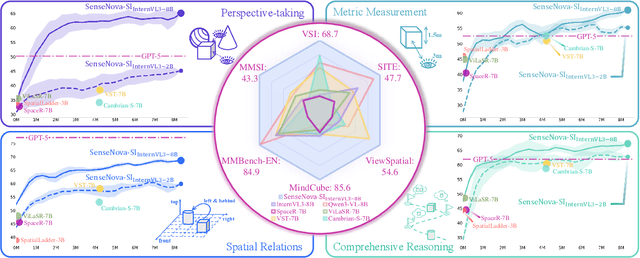
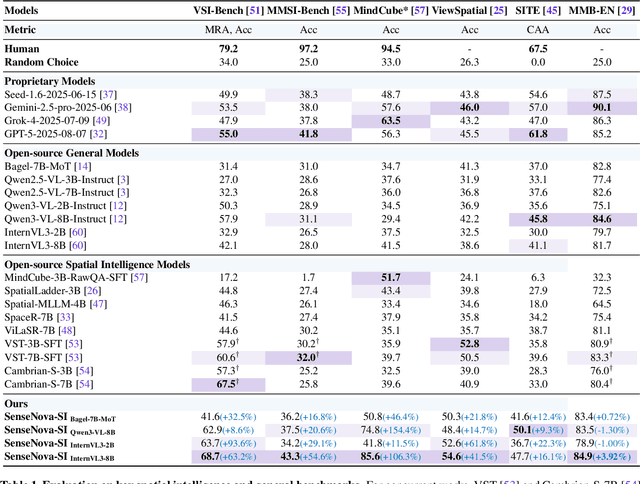
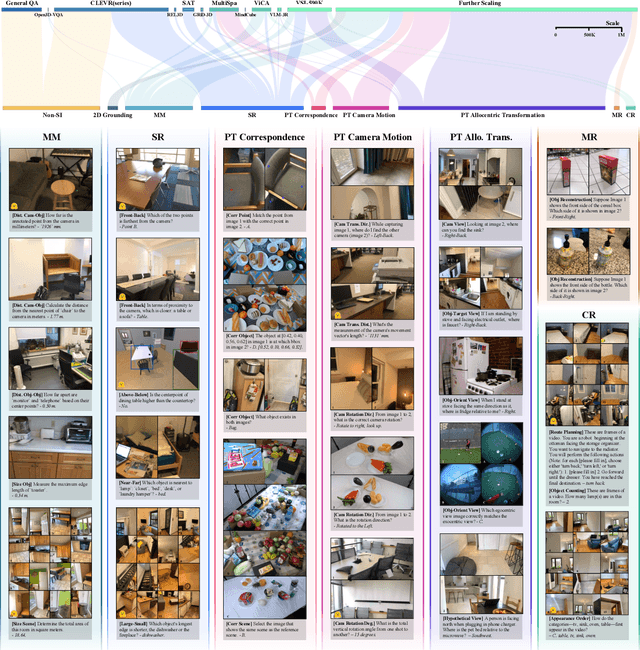
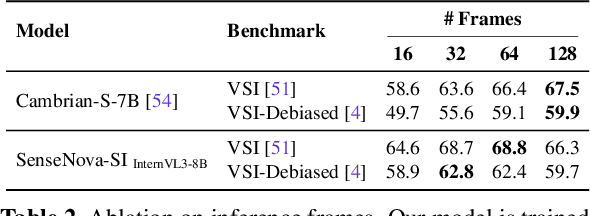
Abstract:Despite remarkable progress, multimodal foundation models still exhibit surprising deficiencies in spatial intelligence. In this work, we explore scaling up multimodal foundation models to cultivate spatial intelligence within the SenseNova-SI family, built upon established multimodal foundations including visual understanding models (i.e., Qwen3-VL and InternVL3) and unified understanding and generation models (i.e., Bagel). We take a principled approach to constructing high-performing and robust spatial intelligence by systematically curating SenseNova-SI-8M: eight million diverse data samples under a rigorous taxonomy of spatial capabilities. SenseNova-SI demonstrates unprecedented performance across a broad range of spatial intelligence benchmarks: 68.7% on VSI-Bench, 43.3% on MMSI, 85.6% on MindCube, 54.6% on ViewSpatial, and 50.1% on SITE, while maintaining strong general multimodal understanding (e.g., 84.9% on MMBench-En). More importantly, we analyze the impact of data scaling, discuss early signs of emergent generalization capabilities enabled by diverse data training, analyze the risk of overfitting and language shortcuts, present a preliminary study on spatial chain-of-thought reasoning, and validate the potential downstream application. SenseNova-SI is an ongoing project, and this report will be updated continuously. All newly trained multimodal foundation models are publicly released to facilitate further research in this direction.
In-Token Rationality Optimization: Towards Accurate and Concise LLM Reasoning via Self-Feedback
Nov 13, 2025Abstract:Training Large Language Models (LLMs) for chain-of-thought reasoning presents a significant challenge: supervised fine-tuning on a single "golden" rationale hurts generalization as it penalizes equally valid alternatives, whereas reinforcement learning with verifiable rewards struggles with credit assignment and prohibitive computational cost. To tackle these limitations, we introduce InTRO (In-Token Rationality Optimization), a new framework that enables both token-level exploration and self-feedback for accurate and concise reasoning. Instead of directly optimizing an intractable objective over all valid reasoning paths, InTRO leverages correction factors-token-wise importance weights estimated by the information discrepancy between the generative policy and its answer-conditioned counterpart, for informative next token selection. This approach allows the model to perform token-level exploration and receive self-generated feedback within a single forward pass, ultimately encouraging accurate and concise rationales. Across six math-reasoning benchmarks, InTRO consistently outperforms other baselines, raising solution accuracy by up to 20% relative to the base model. Its chains of thought are also notably more concise, exhibiting reduced verbosity. Beyond this, InTRO enables cross-domain transfer, successfully adapting to out-of-domain reasoning tasks that extend beyond the realm of mathematics, demonstrating robust generalization.
State-of-the-Art Dysarthric Speech Recognition with MetaICL for on-the-fly Personalization
Sep 19, 2025Abstract:Personalizing Automatic Speech Recognition (ASR) for dysarthric speech is crucial but challenging due to training and storing of individual user adapters. We propose a hybrid meta-training method for a single model, excelling in zero-shot and few-shot on-the-fly personalization via in-context learning (ICL). Measuring Word Error Rate (WER) on state-of-the-art subsets, the model achieves 13.9% WER on Euphonia which surpasses speaker-independent baselines (17.5% WER) and rivals user-specific personalized models. On SAP Test 1, its 5.3% WER significantly bests the 8% from even personalized adapters. We also demonstrate the importance of example curation, where an oracle text-similarity method shows 5 curated examples can achieve performance similar to 19 randomly selected ones, highlighting a key area for future efficiency gains. Finally, we conduct data ablations to measure the data efficiency of this approach. This work presents a practical, scalable, and personalized solution.
Has GPT-5 Achieved Spatial Intelligence? An Empirical Study
Aug 18, 2025Abstract:Multi-modal models have achieved remarkable progress in recent years. Nevertheless, they continue to exhibit notable limitations in spatial understanding and reasoning, which are fundamental capabilities to achieving artificial general intelligence. With the recent release of GPT-5, allegedly the most powerful AI model to date, it is timely to examine where the leading models stand on the path toward spatial intelligence. First, we propose a comprehensive taxonomy of spatial tasks that unifies existing benchmarks and discuss the challenges in ensuring fair evaluation. We then evaluate state-of-the-art proprietary and open-source models on eight key benchmarks, at a cost exceeding one billion total tokens. Our empirical study reveals that (1) GPT-5 demonstrates unprecedented strength in spatial intelligence, yet (2) still falls short of human performance across a broad spectrum of tasks. Moreover, we (3) identify the more challenging spatial intelligence problems for multi-modal models, and (4) proprietary models do not exhibit a decisive advantage when facing the most difficult problems. In addition, we conduct a qualitative evaluation across a diverse set of scenarios that are intuitive for humans yet fail even the most advanced multi-modal models.
CheXPO: Preference Optimization for Chest X-ray VLMs with Counterfactual Rationale
Jul 09, 2025Abstract:Vision-language models (VLMs) are prone to hallucinations that critically compromise reliability in medical applications. While preference optimization can mitigate these hallucinations through clinical feedback, its implementation faces challenges such as clinically irrelevant training samples, imbalanced data distributions, and prohibitive expert annotation costs. To address these challenges, we introduce CheXPO, a Chest X-ray Preference Optimization strategy that combines confidence-similarity joint mining with counterfactual rationale. Our approach begins by synthesizing a unified, fine-grained multi-task chest X-ray visual instruction dataset across different question types for supervised fine-tuning (SFT). We then identify hard examples through token-level confidence analysis of SFT failures and use similarity-based retrieval to expand hard examples for balancing preference sample distributions, while synthetic counterfactual rationales provide fine-grained clinical preferences, eliminating the need for additional expert input. Experiments show that CheXPO achieves 8.93% relative performance gain using only 5% of SFT samples, reaching state-of-the-art performance across diverse clinical tasks and providing a scalable, interpretable solution for real-world radiology applications.
MST-Distill: Mixture of Specialized Teachers for Cross-Modal Knowledge Distillation
Jul 09, 2025Abstract:Knowledge distillation as an efficient knowledge transfer technique, has achieved remarkable success in unimodal scenarios. However, in cross-modal settings, conventional distillation methods encounter significant challenges due to data and statistical heterogeneities, failing to leverage the complementary prior knowledge embedded in cross-modal teacher models. This paper empirically reveals two critical issues in existing approaches: distillation path selection and knowledge drift. To address these limitations, we propose MST-Distill, a novel cross-modal knowledge distillation framework featuring a mixture of specialized teachers. Our approach employs a diverse ensemble of teacher models across both cross-modal and multimodal configurations, integrated with an instance-level routing network that facilitates adaptive and dynamic distillation. This architecture effectively transcends the constraints of traditional methods that rely on monotonous and static teacher models. Additionally, we introduce a plug-in masking module, independently trained to suppress modality-specific discrepancies and reconstruct teacher representations, thereby mitigating knowledge drift and enhancing transfer effectiveness. Extensive experiments across five diverse multimodal datasets, spanning visual, audio, and text, demonstrate that our method significantly outperforms existing state-of-the-art knowledge distillation methods in cross-modal distillation tasks. The source code is available at https://github.com/Gray-OREO/MST-Distill.
 Add to Chrome
Add to Chrome Add to Firefox
Add to Firefox Add to Edge
Add to Edge